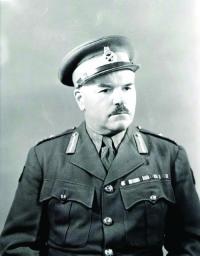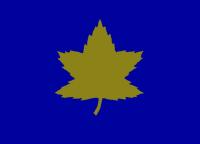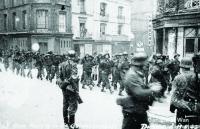
John Hamilton Roberts, Cmdr. Second Canadian Div., which carried the brunt of the Dieppe assault and who was relieved of command afterwards.

2nd Canadian Infantry Div. ensignia.

Captured Canadians being marched through Dieppe.
Dieppe is a Commune in the Seine-Maritime department in France, settled on the shores of the English Channel. On August 19th, 1942 at 0500 hrs. an Amphibious Landing was launched there. The results were a disaster. The raid was conducted mainly to test materiels, equipment, and techniques for future landings in, primarily, North Africa and Normandy.
The landing force was comprised of, mainly Canadian, some English and approximatly 50 American Army Rangers. When it was over nearly 1000 Canadian troops were killed and 2000 captured. In all, 5000 of the 6100 troops involved were Canadians. The loss of aircraft and pilots was nearly as bad proportionately. The Royal Canadian Air Force lost 13 aircraft and 10 pilots, while the Royal Air Force lost 106 aircraft and 81 pilots - the highest single day total of the War.
The main battle plan for the attack was for four flank attacks before dawn, and a main frontal attack a half hour later. But everything, for all practical purposes, fell apart when the main ingredient - the element of surprise - was lost. Landing ships and escort vessels were met on the eastern flank by a small group of German Ships and the resulting battle alerted the Germans of the pending invasion.
The Royal Regiment of Canada landed on Puys Beach on the eastern flank with 500 troops and was met with intense German heavy machine gun fire. All were either killed or captured.
On the western flank, at Pourville, the South Saskatchewan Regiment and Queen’s Own Cameron Highlanders of Ottawa initially met with light resistance, but as they pushed further toward Dieppe, opposition became intense and they were forced to abandon their attack and evacuate. The rear guard never made it out.
The Royal Hamilton Light Infrantry and the Essex Scottish Regiment carried out the main frontal assault on Dieppe. Their tanks became stuck or disabled on the beach as well as being blocked by a seawall and were hammered by German artillery and the troops pinned down by machine gun and heavy weapons fire. A message was sent back to Command Headquarters, which was misunderstood, for some unknown reason, and led Command to believe the Essex Scottish Regiment was making progress and the reserve battalion of the Les Fusiliers Mont-Royal was sent in and were also pinned down on the beach resulting in a virtual shooting gallery for the Germans. A General Order for withdrawal was issued at 11 am.
Those interested in the events of World War II after reading the lead in to this invasion as stated above are by now shaking their head wondering why such a sacrifice of men and material was allowed to happen at a location so heavily defended and of questionable strategic importance. The answer, I believe, is extremely complex. The European Allies had not embarked upon a major invasion thus far in the War. Somewhere in the deepest recesses of Military Tactical Planning, an invasion of North Africa was being born. Down the road the Allies also knew that at some point in the war the Continent of Europe would have to be invaded. The Raid on Dieppe was an early tactical lesson to basically learn how an invasion should, or should not, be conducted. It was an experiment! It turned out to be a lesson in what not to do in an invasion with 5 very important tactical lessons learned that were needed for a successful invasion: (1)The need for massive artillery support and aerial bombardment; (2)The need for a sustained element of surprise; (3)The need for good intelligence of enemy fortifications; (4) The avoidance of a direct frontal assault of a defended port city; (5)The need for re-embarkation craft.
There was one more element not mentioned and not discussed that I found in my research and that was the element of secrecy. The BBC, in London, had broadcast that the French population should evacuate the areas along the Atlantic Wall due to the possibilities of future battles. A Canadian soldier evacuated from Dieppe stated, "...the Germans had a state of preparedness as if they knew an attack was coming and their artillery fire on the invasion fleet and concentrated fire on the beaches was spot on." Several veterans believed the Germans were aware of THIS pending assault. Taking into account the amount of planning, secrecy, misinformation, men, materiel and planning that went into the Normandy Invasion it would appear the losses at Dieppe were, however, not in vain.
My late father, who ran LCVP's (Landing Craft, Vehicle Personnel) i.e. Higgins Boats, in the Invasion of North Africa and Normandy, once told me that during those landings it wasn't until 1 hour prior to embarkation that he knew what personnel or equipment he would be transporting, on which beach he was going to land, or what kind of resistance to expect, or the exact time he would launch. But through it all there was always "scuttlebutt" circulating around the ship about the pending invasion and more often than not the rumors were true. As I sit here writing this article I can't help but to drift back to some of my dad's experiences during the war and I can assure anyone reading this, that the horrors of the troops landing on those beaches, wherever they were, was nothing we of this generation could comprehend.
It is hard to justify whether or not the Dieppe Raid was worth its loss in blood, but it was claimed to be a necessary evil. Vice-Admiral Lord Louis Mountbatten of Combined Operations Headquarters planned the Raid on Dieppe. Later, Lord Mountbatten would say of the Raid on Dieppe, "I have no doubt that the Invasion of Normandy was won on the Beaches of Dieppe. For every man who died on the beaches of Dieppe 10 were saved in the Normandy Invasion." Winston Churchill said, "My impression of Jubiliee (code name for the Raid) is that the results fully justified the heavy cost and it was a Canadian contribution of the greatest significance to final victory." Two months later the Invasion of North Africa was launched. Two years later the Allied Forces invaded the Continent of Europe on June 6th 1944.
History would show that the Dieppe Invasion was the shortest in Military History. It commenced at 0500 hrs. Withdrawal was ordered at 1100 hrs and completed at 1400 hrs. for a grand total of 9 hours with a combined loss of either killed, wounded or captured of 4200 men, or 467 per hour, not counting lost ships, landing craft, and aircraft. German forces lost 311. Did the end justify the means? If 10 men were saved on the Beaches of Normandy for every 1 killed at Dieppe then I would say, yes. But how do they know?
note to the Editor:
I wish to thank Pete Wimbrow for inviting me to write a column every so often. I am not, nor have I ever been, a professional Historian, Writer or Expert on World War II and nearly flunked English in High School, but I always enjoyed writing and researching my assignments to gather the information and put it down, in hopes you will enjoy the read. I can also say that writing these articles has given me a renewed sense of pride in our Country and upon meeting any of our present day warriors, and warriors from the past, I stand humbled in their presence.
NEXT WEEK: GUADALCANAL
«Go back to the previous page.


